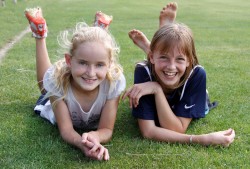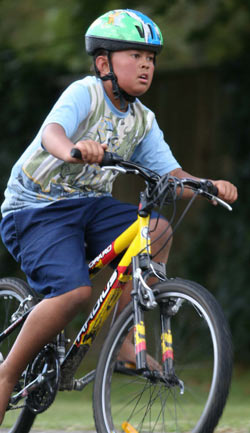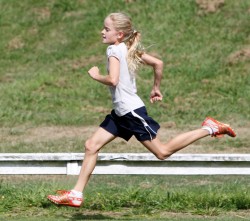|
Fitness Blog Covering Topics Of Interest Wednesday, January 23 2013
Remember when a total cholesterol reading of under 200 was the standard for judging cardiovascular health? Today, of course, we know that it's the components of cholesterol (LDL, HDL, the size of those cholesterol particles, and triglycerides) that are much more predictive of heart health. Well, our understanding of total weight and its effects upon your heart has evolved in similar fashion. It's not your total weight but the characteristics of that weight—how much is fat and where it's deposited—that matter most.
Surprised? Thank the scientists at the Mayo Clinic, who are behind this recent discovery. After comparing various health markers with the weights and body mass index numbers of thousands of adults, they found that more than half of those with normal weights and BMIs actually had "high body-fat percentages as well as heart and metabolic disturbances." In other words, they had the same risks of coronary disease, diabetes, and other chronic illness as people who weighed much more. This research, and its sobering implications for millions of Americans, led to the establishment of a new condition called normal weight obesity (NWO). This is more than just the latest fat phobia. It's worth paying attention to because the accumulation of fat in the body, especially in the belly and around internal organs, causes low-level inflammation that gradually damages tissue and blood vessels. (Think of it as metabolic rust.) So even though your weight or BMI may be within acceptable limits for your height and age, don't be lulled into a false sense of security. Do your own analysis, starting with these steps: 1. Stop being preoccupied with pounds. As with total cholesterol, total weight is just one general assessment of your health. Yes, people who are trying to lose weight are more likely to succeed if they weigh themselves often. But seeing numbers that are within a healthy BMI range may actually disguise your heart disease risk. Keep them in perspective. 2. Measure your body fat. For a quick estimate of this key factor, wrap a cloth measuring tape around your naked waist just above your belly button. If your weight is fairly normal but the number you see above your navel is 35 inches or more (40+ inches for men), you may have NWO. For a more exact reading, ask your doctor (or health club) to measure your body fat. This can be done using a variety of noninvasive methods. If it's higher than 30 percent (20 percent for men), you likely have NWO. 3. Get a blood test. Ask your doctor to order a thorough blood analysis at your next physical. Warning signs of NWO include low HDL (total cholesterol and LDL may be normal), along with elevated triglycerides, blood sugar, and blood pressure. 4. Target belly fat. If you're diagnosed with NWO, take aim at visceral fat. Despite how entrenched it may seem, you can lose it. The keys are: Avoid the white stuff (white bread, rice, pasta, and other refined carbohydrates). Add monounsaturated fats, which target belly fat, to your diet. And do interval exercises to burn more fat and strength-training to build lean body mass. 5. Keep tracking fat. Just as you hop on the scale to keep tabs on your weight, do the same with your body fat. Have it measured periodically at your doctor's office or health club. Or just observe the notches where your belt buckles. Conversely, if you're considered overweight by current standards, there may be some good news here. If your body-fat percentage is lower than 30 percent (20 percent for men) and your blood chemistry is normal, then you are among the "fat and fit." (Many athletes are in this category.) Continue to eat smart and exercise, but accept your body for what it is and know you're not unhealthy because of it. Feeling fat and feeling healthy are no longer mutually exclusive. More Heart-Healthy AdviceStaying hydrated is one simple way to keep blood pressure in the safe zone.Tuesday, December 18 2012
About A.B.C.D.E.
Every child needs to learn the ABC’s of life. When it comes to establishing healthy habits, you can teach them how to “ABCDE” (Act Boldly to Change Diet and Exercise). Why is this important?
What are the benefits of good nutrition and daily exercise for kids?Mental and behavioral benefits
Physical benefits
What are the effects of different settings on the eating and exercise habits of kids?In the home:
At school:
In the neighborhood:
Why are you critical to establishing healthy behaviors in your kids?
Monday, November 12 2012
The story of a four-year-old boy in India who has been running distances of up to 60 kilometers has led to a lot of discussions, including among the Take The Magic Step® team. We spoke to Dr. Henning Ohlert about appropriate exercise for young children, as well as about some strategies for parents to deal with this issue. Dr. Ohlert, 46, is a lecturer of training science at the University of Potsdam. He was a professional athlete for ten years, and as a 23-year-old ran the 800 meters in 1:45.9. He is working on a long-term study of motor skills and development of ten-year-old children.  © Betty Shepherd How much exercise can a child cope with? Over the years, our attitude towards children’s capabilities has changed tremendously. Basically, you could say that children are “little champions of endurance.” The big advantage of children is that they stop what they are doing automatically when they feel that they are getting tired and reach their physical limits. If children are tired out during playing, they simply take a break, and once they have recovered, they get active again. I think that you cannot do anything wrong with children-you just cannot challenge them physically in the wrong way. They know how to adjust themselves, and will utter their disapproval when it gets too much for them. And this disapproval should be respected. What you have to watch out for with children, however, is problems with their thermoregulation; that is, the loss of body warmth during physical activity. Children get red faces when they are playing, bouncing around or playing sports. The body warmth which develops causes fast panting while breathing. The reason for this is that their perspiration system with does not function as that of an adult yet. That’s why you have to be careful to prevent children from overheating. In general, however, children have quite a sensitive feeling for the right proportion of activity and rest. It is highly dangerous, though, what is demanded of the little boy in India. How can parents tell what and how much they can expect and ask from their children? I believe you can ask more from children than most parents would think. You can judge by certain subjective criteria if a physical activity is enough: the color of the skin (for example, if the paleness of the skin is extreme), the frequency of the breath, the heart rate as well as the quality of movements. You will realize pretty quickly that movements seem to become uncontrolled and the way children fall changes. These are clear indications for the necessity of a break.  © Betty Shepherd At what age should children start to train on a regular basis? In order to answer this question, you would have to define the term “systemically organized training” first. I think that until a child has reached the age of eight, we shouldn’t call it training. There is nothing wrong with daily exercise or physical activities. Children should be active in various non-specific ways and thereby gain a broad range of experiences. This is the best prerequisite for successful involvement in sports later on. Is there such a thing as unathletic children? In my opinion, there is no such thing as unsporty kids. At times someone gets called “unathletic” just because he is judged by certain skills and abilities. It is just normal, however, that you are not able to do things which you have never done or practiced before. Often you get also judged by your family background. But just because your parents consider themselves unathletic, it does not necessarily have to mean that the son or daughter is as well. Every child is athletic. The question is only if she is athletic enough to become a champion. Don’t children have a natural urge to move? Absolutely. Unfortunately, this urge is lost throughout the ontogenetic development. At puberty, this urge to move decreases. This is when young athletes often lose interest in their sport and don’t show up for training anymore. Should parents try to intervene? It would not be good if the enthusiasm for the sport got completely lost. It is normal and should be tolerated that there are phases of less motivation. You should still try to talk to your child, his or her coach and friends about the situation, options and possible wasted opportunities. Children tend to change their enthusiasm for different things quite quickly. Today they are playing tennis, tomorrow they want to become a professional swimmer, the day after tomorrow a famous basketball player. Sometimes they are not sure at all. Should children do several kinds of sport or should they better concentrate on one? I strongly recommend that children experience a rather broad range of physical activities. I assume that not every child should be trained to become a Davis Cup player. Instead, most children will just want to play tennis for fun, or they just want to go inline skating, running or play soccer. I am a great supporter of children practicing a variety of sports. Is it naive to believe that children will be grateful one day if parents put some pressure on them and force them to keep up a certain sport, hoping that they will be successful and the sport turns out to be the right one for the child? This wish or hope might be honorable, but children think differently. Children think very emotionally, and are not as rational as adults are. The reasons why children give up on something are not easily understood. A little bit of pressure might not be wrong. It is a great achievement, however, if children discover themselves what they like. Should parents tell their children which expectations they have regarding their sporting performance? Parents’ expectations should not put too much negative pressure on the children. There is a lot of evidence in pedagogy that children fail just because their parents were asking too much of them. Children often act paralyzed if they are put under too much pressure. Then they are often criticized for failing mentally, but no one realizes how much pressure has been put on them: “You have to do this, you have to do that!” Parents have to learn to judge their children’s mental condition and figure out how they can teach them ambition and determination. As a matter of fact, a runner participates in a race to get to the finish line among the best and not far behind the first ones. Consequently, you can, of course, tell your children that sport is often about being better and faster than others. This should be done sensibly, however, and without any pressure. It is nearly impossible to get children’s enthusiasm back if you have put them off doing sports once and if sports have become a trauma for them. This is proven by scientific research. The next chance you get to convince them of doing sports again is when they have grown up and when stress at work and an unhealthy diet have caused health problems and the cardiologist tells them, “You have to get moving, you have to exercise!”  © Betty Shepherd On the other hand, children are often highly motivated when their parents watch them at training or competitions. It is obvious that children are extremely motivated when they realize that their parents fully support what they are doing. At some stage, however, their own motivation will become so high that they don’t need their mother’s or father’s support anymore. But even professional athletes are more motivated when their parents are in the stadium or along the race course, no matter if in tennis, soccer or running. The question is just how parents react to their children’s failure. It is important that you find out together-maybe even with the coach-where mistakes might have been made and how you could adapt the training. Children have to feel that you support them and don’t give up on them. What should parents do if their child suddenly, after two years, does not like judo anymore and would rather want to do athletics or tennis? Should parents demand that their children continue doing what they have started to do and not to give up on something just because it is no fun at the time? I don’t find it too bad to change from one kind of sport to the other. You should have a conversation and clarify why they don’t like the sport they used to do anymore. There are certainly understandable reasons for it. And if they are not understandable, you still should not act against your child’s wish. What should parents do if they recognize sporting talent in their child, but are not sure if they want to support it? If someone thinks his child has got talent in some area which is illustrated by being better at something than other children of the same age, I would recommend approaching a sporting club close by and asking if there are facilities to support this talent specifically. I don’t find it very good to place children in “talent factories” far away from home where they waste a lot of time traveling to and from the place. Children should be able to pursue their training without many hassles. If they further develop and prove their talent, there are more opportunities of support in young adulthood, such as elite sporting schools or scholarships. And vice versa: How are mothers and fathers to act if children desperately want to become professional athletes, but just seem to lack the talent? I would still give the child the same chances, as eventually the “moment of truth” will show if the child is as good as she thinks she is. In cases of constant failure, however, you should be honest with your child, and tell him that another kind of sport might be more suitable for him. There are a lot of children who change to another kind of sport after the advice of a friend or parents and who have become really successful at it. Children who are motivated and ambitious should initially do what they prefer and should try things out. If parents for some reason think that they should apply sanctions against their child-maybe because of bad marks at school-are prohibiting going to training and doing sports reasonable disciplinary measures? I find prohibiting sports as punishment pedagogically not wise. Children have a natural urge to move and to play in order to cope with stress and emotions, and you cannot just switch this behavioral pattern off. If they are aggressive at school, they will be aggressive at sports, too. But particularly here, those negative emotions can be turned around into positive ones-through the pure movement, through the contact with the coach, through the group dynamics in team sports where bonding and camaraderie are crucial. Friday, September 07 2012
Toddlers are struggling to reconcile their autonomy with parental control. On this age group, children try to assert their autonomy by saying no. In fact, toddlers can say no to virtually anything. One moment they refuse to eat a bowl of cereal, but a few minutes later they turn around to demand the same bowl after you have thrown away its content. Parents and caregiver should set boundaries and limits for toddlers. You may doubt this, but a little frustration is healthy for your children. They should know things that they can’t get and know their limits. Even so, you should respect your children’s opinions, if they say no, listen and respond to your children’s words. It will show them that they have control on their lives. By choosing battles wisely, you can avoid unnecessary power struggles. For example, they may want to wear winter hat on the beach, just let them. However, if they insists on playing near a busy street, that’s certainly non-negotiable.
Setting and Respecting Boundaries Boundaries separate people; they define expectations and simplify life. Well-established boundaries can help toddlers to feels safe and know about limits in life. These are common boundaries in the family: • Knocking before entering a bedroom • Asking permission before playing on the lawn • Prohibition on hitting and other violent physical contacts • Don’t play with Mom’s cooking utensils • Wear proper clothing when playing outside during cold days • Hold Mom’s hand when crossing the street Boundaries can only be effective if parents can become a reliable role model and behave properly, as the result toddlers can grow into a young child with good attitude and healthy relationships with other family members and friends. These are a few things you should consider when attempting to establish boundaries: Be consistent. Children, especially toddlers will be confused when they face changing limits and rules. Adjust yourself to your children’s development. You should make sure that they are physically and emotionally capable of obeying boundaries. Boundaries is not only about controlling your child, they help to teach self-discipline and keeping them safe. Massaging can also help to set boundaries. You should ask for their permission before giving them a massage. You can also teach your children to massage each other and make it into something exciting. Observe your children's continuously, if they feel uncomfortable, you should take it easy and if they look bored, talk to them. Each child has unique preference, some love to have their legs massaged, while others want to have their backs rubbed. Teaching Discipline Through Massage If you want your child to be receptive to gentle discipline, massages can give you a good opportunity of establishing that kind of relationship. These are a few things to consider if you want your child to respond favorably to your loving guidance: • Build trust. • Set consistent and clear boundaries. • Teach your child to communicate properly. • Let your child know that you’re being sensitive to their needs. Discipline is all about teaching to your child to stay within boundaries. Massage is a good way to teach about discipline, because your child will become familiar to trust, boundaries and nonverbal communication. In fact, infants can pick up lessons about boundaries and discipline through massage. By offering massage regularly, parents can become sensitive caretakers who are perfectly attuned to their child’s needs, which will nurture a relationship based on trust. Children who get proper responses to their needs with sensitivity and compassion will grow up with feeling of respect and they can rely on your positive authority. Of course, you shouldn’t be a pushover, but when asserting your positive authority, you should be firm without being overbearing or controlling. By expressing positive authority properly, you can strengthen mutual respect and trust with your children in a cooperative and non-adversarial way. As you become more aware of their changing needs, sensitive and attuned, your relationship will evolve and grow as they do. Handling Tantrums Understanding why tantrum occurs is the first step in controlling it. Toddlers tend to have temper tantrums each time they’re overwhelmed with feelings they can’t or don’t know how to handle. Common triggers are anger, frustration, hunger and fatigue. Often temper tantrum occur in public places and it can be difficult to figure out to best handle the situation with everyone is watching. Temper tantrums are very frustrating for both of you. After they are calm you have to talk about what had happened, by giving them a massage, it will remind them that they do have the skills to calm themselves down. These are things to remember when temper tantrum strikes: • Try to remain calm and objective • Hold your child so they won’t get hurt • If possible, bring them to a quieter place It is important to be properly responsive to a child who is experiencing a tantrum. Many times, tantrum happens when the child can’t handle intense emotions, so the best thing you can do is to stay with them and remain loving. There is no fixed rule for this, because each child is unique, so do the relationship between child and parent. You should be intuitive, use soothing words but try to remain firm if necessary. Many parents reported that talking to their children after a tantrum episode, while giving a massage can help immensely. It can help your child to express their opinion, while at the same time, your child will become more receptive to your advices. |
 |



 Oftentimes, toddlers refuse a massage. When it happens, respect their wish as it sends a clear message that their body is completely theirs and others will respect it. Obviously, you should respond properly when they wants a massage. You may be busy at certain times, but if you can establish a predictable schedule, both of you will feel more comfortable. Accommodating your children’s needs show them that you’re being helpful in guiding them toward independence and self-reliance. Remember that childhood needs that are properly met will go away, while those that can’t be met will be carried well into adulthood.
Oftentimes, toddlers refuse a massage. When it happens, respect their wish as it sends a clear message that their body is completely theirs and others will respect it. Obviously, you should respond properly when they wants a massage. You may be busy at certain times, but if you can establish a predictable schedule, both of you will feel more comfortable. Accommodating your children’s needs show them that you’re being helpful in guiding them toward independence and self-reliance. Remember that childhood needs that are properly met will go away, while those that can’t be met will be carried well into adulthood.